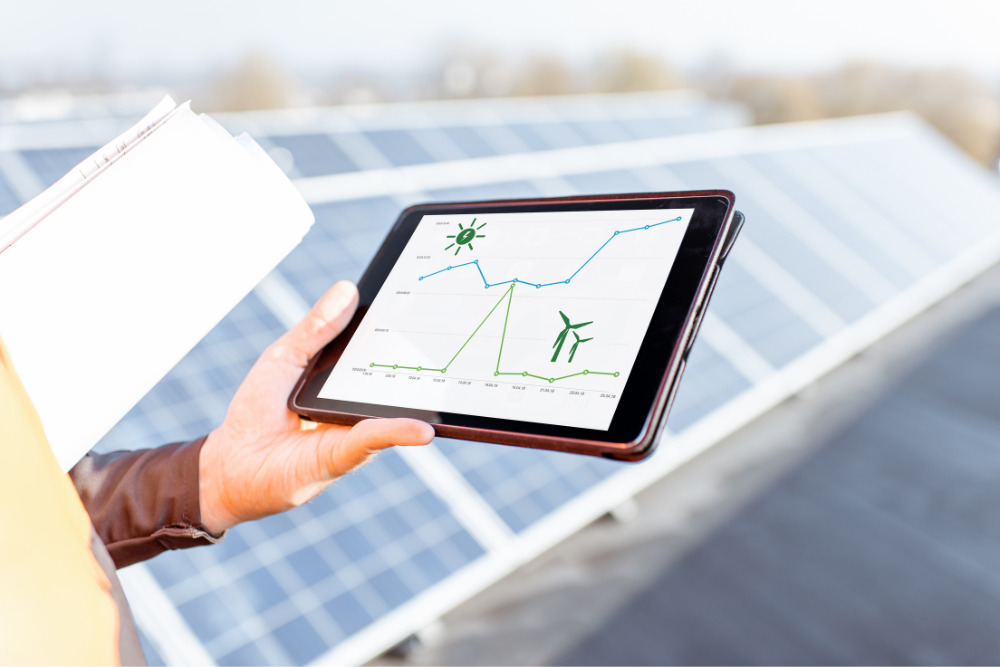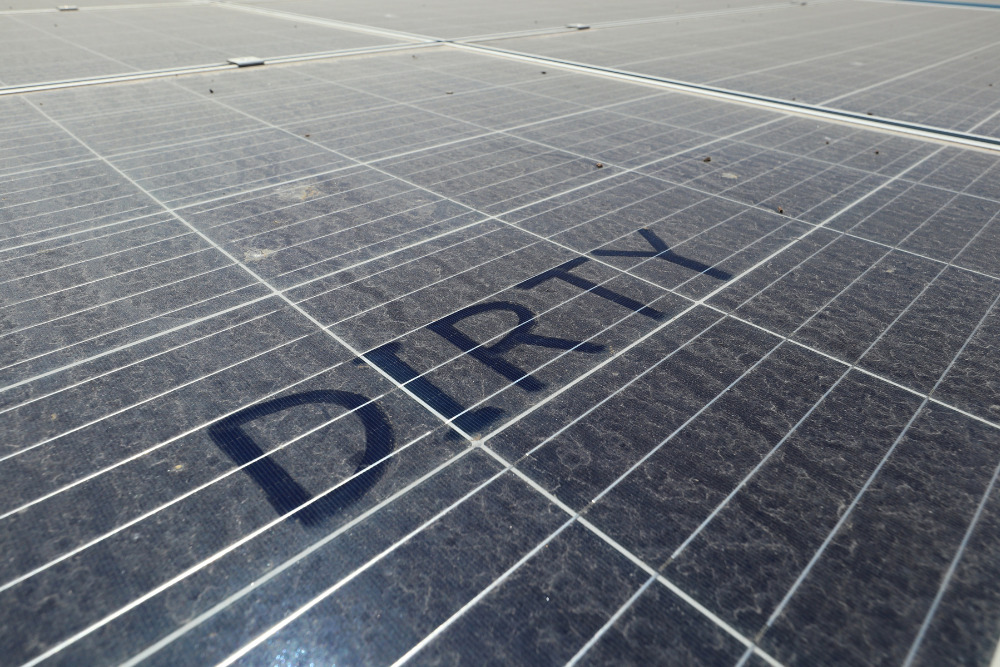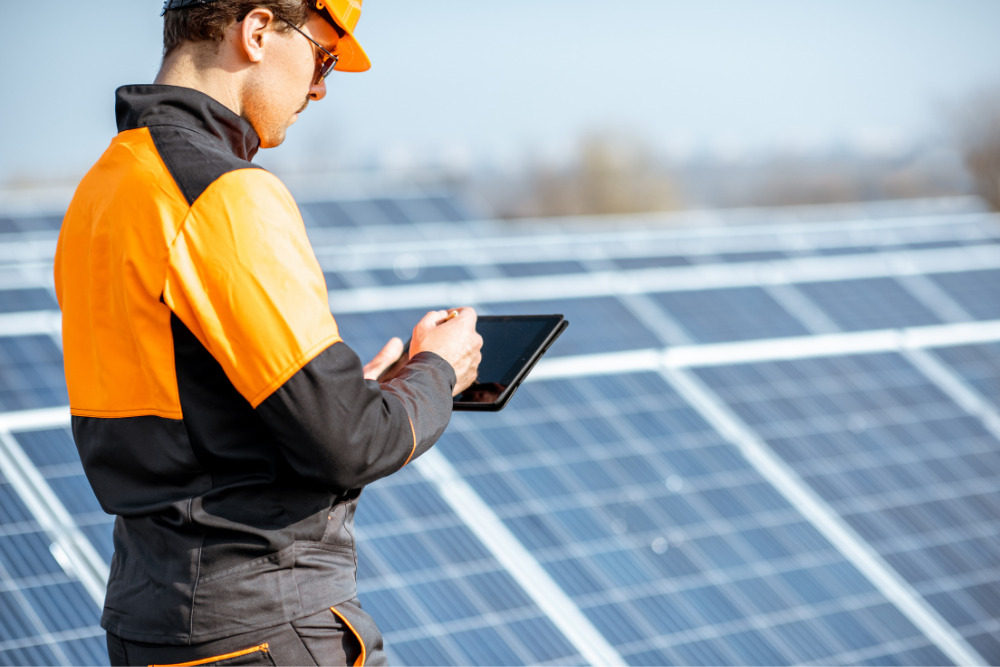
Solar panel performance monitoring systems are designed to track and analyze panel performance and home energy use. These systems collect real-time data on various parameters such as energy production, voltage, current, weather conditions, and usage patterns.
By continuously monitoring your solar panel system’s performance, you can identify and fix any issues that may affect energy output. The monitoring systems provide detailed insights into the overall health and performance of the solar array, allowing for early detection of potential problems like shading or equipment malfunctions.
These systems often include user-friendly interfaces or mobile apps, allowing solar system owners or operators to access and analyze the data remotely.
How Does Solar Panel Monitoring Work?
Solar panel monitoring works by collecting and analyzing production data related to the performance and output of solar panels. There are two main types of monitoring: built-in inverter monitoring and third-party monitoring.
Built-In Inverter Monitoring Vs. Third-Party Monitoring
Built-in inverter monitoring is commonly found in modern solar systems. Solar inverters convert DC power generated by solar panels into AC power and have built-in energy monitoring capabilities. They collect data on parameters like energy production, voltage, and current, and transmit it to a central monitoring platform. This type of monitoring is typically included with the solar system and does not require additional hardware.
Third-party monitoring involves the use of external monitoring systems or devices that are independent of the inverters. These monitoring systems may offer more advanced features and analysis capabilities. They often use additional sensors or monitoring devices installed at the module or string level to collect more detailed data.
Total Solar Power Production Vs. Module-Level Monitoring
Solar monitoring systems can track the total solar power production or provide module-level monitoring.
Total solar power production monitoring offers an overview of the entire system's performance, combining the data from all the panels. It provides a holistic view of the system's efficiency and energy generation.
Module-level monitoring uses microinverters to provide a more granular level of monitoring by enabling module-level data collection and analysis. This provides precise tracking and optimization of individual solar panel performance and the early detection of issues with specific panels, such as shading, dirt accumulation, or malfunctioning equipment.

Solar Monitoring for Grid-tied Systems Vs. Off Grid Systems
Solar monitoring for grid-tied solar panel installations primarily focuses on optimizing performance, maximizing energy production, and ensuring compliance with grid requirements, especially with net metering billing.
Solar monitoring for off-grid systems manages system output, consumption, and storage to maintain a reliable source of renewable energy in remote off-grid locations that use solar storage systems (solar batteries).
How Solar Monitoring Systems Relay Information
The communication of system data can occur through different methods.
Hardwired connections use cables to connect the monitoring devices to the central monitoring platform. This communication method is more common in off-grid systems with no internet connection.
WiFi and cellular connectivity allows data to be transmitted wirelessly over a computer or mobile device. The choice of communication method depends on factors such as system size, location, and available infrastructure.
What Are Some Solar Consumption Monitoring Components, And What Do They Do?
- Power optimizers are devices installed at the module level that optimize the power output of individual solar panels, increasing the overall energy harvest. These optimizers enhance monitoring capabilities by providing real-time voltage, current, and module-level performance data.
- Charge controllers regulate the charge and discharge of batteries in off-grid solar systems. These controllers monitor the battery state of charge, input from solar panels, and energy consumption, ensuring optimal battery performance and preventing overcharging or excessive discharge.
- Modbus is a communication protocol widely used in solar monitoring systems. It enables seamless data exchange between components, such as inverters, optimizers, and monitoring devices.
- String inverters convert the DC power generated by solar panels into AC power. When integrated with monitoring capabilities, string inverters monitor the overall system performance, including energy production, voltage, and current. Monitoring string inverters allows users to track the aggregated output of multiple series-connected panels.
Why Is Solar Consumption Monitoring Important?
Solar consumption monitoring allows users to understand their energy usage patterns and make informed decisions about optimizing their energy consumption.
It helps users assess the effectiveness of their solar systems and measure their return on investment. By comparing solar energy production to the energy consumed, users can evaluate their solar installations' financial and environmental benefits.
Monitoring solar consumption enables users to identify any discrepancies or abnormalities in their energy usage. It can help detect potential issues such as equipment malfunctions, energy leaks, or excessive consumption, prompting action to address them and prevent energy waste.
It can also aid in load management and energy planning. By understanding their energy consumption patterns, users can make informed decisions about when to schedule energy-intensive activities, optimize the use of appliances, or plan for battery storage needs in off-grid systems. This leads to better energy management and increased self-sufficiency.

Will Monitoring Your Solar Panel Performance Save You Money?
Monitoring your solar panel performance can save you money by closely tracking the performance of your solar panels. You can quickly identify any issues or under-performing panels affecting your energy production.
Prompt maintenance or repairs can be undertaken, maximizing the efficiency and output of your solar system, thereby increasing the amount of energy you generate and reducing the need to purchase electricity from the grid.
Additionally, monitoring can help you identify opportunities for optimizing your energy usage, leading to further cost savings by maximizing the consumption of the solar energy you produce.
What Is The Best Solar Panel Monitoring System?
Determining the best solar panel monitoring system is subjective and depends on specific needs, preferences, and the characteristics of the solar installation.
Enphase Enlighten is a web-based monitoring system that allows you to track your solar system's performance in real time. Its simple-to-use interface tracks your energy production, monitors your system health, and shares your data.
SolarEdge Monitoring is another web-based monitoring system that offers many of the same features as Enphase Enlighten. However, SolarEdge Monitoring software also includes features that allow you to monitor the performance of individual panel output. This helps in identifying and troubleshooting problems with your system.
SMA Sunny Portal and Fronius Solar.web are web-based monitoring systems that allow homeowners to see how much energy your system produces, how much energy you use, and how much money you save on electric bills. They also include some features that help you troubleshoot problems with your system and optimize your energy usage.


